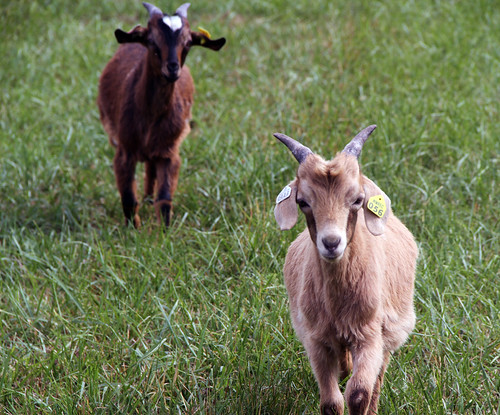Individual fecal samples were collected from each goat on June 10, the official starting date of the test. Unfortunately, it was not possible to collect samples from 11 goats, due to their liquid feces. The samples were sent via overnite mail to Delaware State University. Fecal egg counts were determined using a modified McMaster procedure.
For the goats on the pasture test, fecal egg counts (FECs) ranged from 0 to 5,675 eggs per gram of feces (EPG) and averaged 734 epg. This is similar to last year, when incoming fecal egg counts ranged from 0 to 7,000 and averaged 682 epg. For the goats in the pen, egg counts ranged from 0 to 1,200 epg and averaged 612 epg. For the pooled fecal sample that was collected on June 3-4, fecal egg count was determined to be 350 epg.
Fecal egg counts include eggs from strongyle-type worms: Haemonchus contortus (barber pole worm), Trichostrongyles spp., and Teladorsagia sp. It is not possible to differentiate the stronglye-type worms (except Nematodirus sp.) from the egg stage. The pooled sample also included some Tricuris (whipworm) eggs and a "moderate" amount of coccidia oocytes.
In the test, fecal egg counts are NOT used to make deworming decisions. They are used to determine genetic differences in parasite resistance among the bucks on test. Parasite resistance is a moderately heritable trait.
It is estimated that 20 percent of the animals in a herd are responsible for shedding 80 percent of the worm eggs onto pasture. The goal should be to eliminate the heavy egg shedders from the herd. It is very important to use bucks that are more resistant to internal parasites than the average goat.
Parasite resistance (FECs) and resilience (FAMACHA) are not the same traits, though they are often correlated. In other words, it is quite possible for a goat to have a low egg count, yet require deworming (based on clinical symptoms) and vice-versa. Consider a goat that is loaded with L4 immature worms, but not adult worms. L4s suck blood but do not lay eggs.
Download updated June 10 report with FEC data
For the goats on the pasture test, fecal egg counts (FECs) ranged from 0 to 5,675 eggs per gram of feces (EPG) and averaged 734 epg. This is similar to last year, when incoming fecal egg counts ranged from 0 to 7,000 and averaged 682 epg. For the goats in the pen, egg counts ranged from 0 to 1,200 epg and averaged 612 epg. For the pooled fecal sample that was collected on June 3-4, fecal egg count was determined to be 350 epg.
Fecal egg counts include eggs from strongyle-type worms: Haemonchus contortus (barber pole worm), Trichostrongyles spp., and Teladorsagia sp. It is not possible to differentiate the stronglye-type worms (except Nematodirus sp.) from the egg stage. The pooled sample also included some Tricuris (whipworm) eggs and a "moderate" amount of coccidia oocytes.
 |
| Kiko x Spanish |
In the test, fecal egg counts are NOT used to make deworming decisions. They are used to determine genetic differences in parasite resistance among the bucks on test. Parasite resistance is a moderately heritable trait.
It is estimated that 20 percent of the animals in a herd are responsible for shedding 80 percent of the worm eggs onto pasture. The goal should be to eliminate the heavy egg shedders from the herd. It is very important to use bucks that are more resistant to internal parasites than the average goat.
Parasite resistance (FECs) and resilience (FAMACHA) are not the same traits, though they are often correlated. In other words, it is quite possible for a goat to have a low egg count, yet require deworming (based on clinical symptoms) and vice-versa. Consider a goat that is loaded with L4 immature worms, but not adult worms. L4s suck blood but do not lay eggs.
Download updated June 10 report with FEC data











